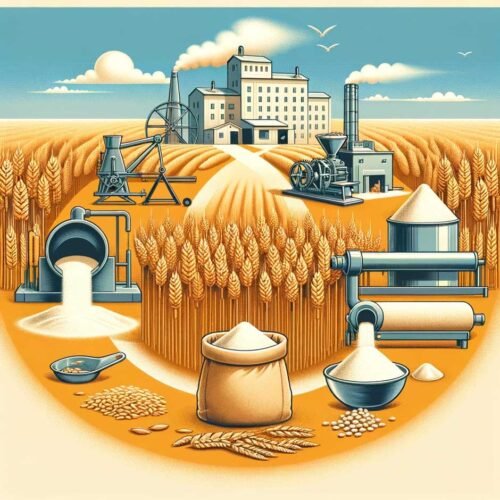In modern agriculture, the concept of “field to fork” has become a powerful reminder of the complex journey that food takes before it reaches our plates. For specialty grains, this journey is not just about cultivation and processing; it is a story of sustainability, innovation, and community. Let’s embark on a deep dive into the fascinating lifecycle of field-to-fork grains and uncover the processes, people, and passion behind every kernel.
The Roots: Planting the Seeds of Specialty Grains
It all begins in the field, where farmers carefully select and plant specialty grains—varieties prized for their unique flavors, textures, and nutritional benefits. Unlike commodity grains that are often mass-produced, specialty grains like farro, quinoa, spelt, and heritage wheats are cultivated with precision and care.
Farmers working with these grains often practice regenerative agriculture, a method focused on enhancing soil health, promoting biodiversity, and reducing the use of synthetic inputs. They consider factors such as soil composition, microclimate, and crop rotation schedules to ensure optimal growing conditions. Seed selection is a crucial part of this process, as heirloom and ancient grains are often less resistant to modern agricultural stresses but deliver a richer nutritional and culinary profile.
The Harvest: Timing and Technique
Harvesting specialty grains is a delicate balance of timing and technique. Too early, and the grains may not have reached full maturity, compromising yield and quality. Too late, and the grains can become over-dry, reducing milling efficiency or risking spoilage due to weather exposure.
Many farmers choose to harvest at dawn or dusk when moisture levels are ideal, and they often use smaller, more precise equipment to minimize damage to the grains. Unlike large-scale industrial harvesting, specialty grain farmers may need to adjust machinery settings frequently, clean equipment between crops to prevent contamination, and even hand-harvest certain varieties to preserve their integrity.
Post-harvest, grains are carefully cleaned, dried, and stored in temperature-controlled silos or bins to maintain freshness and prevent infestation. This meticulous handling preserves the unique qualities that make these grains so special.
Processing: From Whole Grains to Culinary Ingredients
Once harvested, field-to-fork grains move into the processing stage, where they are transformed into various culinary products such as flours, meal, or even finished goods like crackers and pastas. The processing of specialty grains is often done in small batches, using stone mills or low-temperature roller mills to preserve flavor and nutritional content.
For instance, a whole grain flour retains the bran, germ, and endosperm, offering a higher fiber and nutrient profile than refined flours. Specialty millers and processors focus on minimal intervention, avoiding excessive bleaching, enriching, or refining, which can strip away the unique character of the grain.
This careful processing ensures that the grains’ nutritional density and culinary versatility remain intact, ready to delight chefs, bakers, and home cooks alike.
Distribution: Getting Grains to Market
The journey from field to fork involves a critical logistics phase—distribution. Specialty grains often travel shorter supply chains than commodity grains, enabling a more direct connection between farmers and end users. Many specialty grain producers sell through farmers’ markets, food co-ops, and direct-to-consumer models, which not only preserve freshness but also foster a sense of community.
Careful packaging and transport conditions are essential for grains that reach broader markets. Grains must be stored in food-safe containers, often with oxygen absorbers or desiccants, to maintain quality during transit. Cold chains may also be used for particularly sensitive products, such as sprouted grains or flours prone to rancidity.
The Culinary Stage: Grains on the Plate
When field-to-fork grains finally reach the kitchen, their true potential is unlocked. Chefs and artisans around the world celebrate these grains for their depth of flavor, versatility, and nutritional benefits. From rustic sourdough breads made with einkorn flour to colorful grain bowls featuring heirloom quinoa, specialty grains have found a place in both gourmet and everyday meals.
For home cooks, specialty grains offer an opportunity to explore new textures and flavors. Cooking with grains like freekeh or teff can elevate dishes, introducing subtle nutty notes or satisfying chewiness that simply can’t be replicated with standard grains. Additionally, many specialty grains are gluten-free or low-gluten, providing options for those with dietary restrictions.
The Sustainability Connection
The field-to-fork grains movement is not just about great taste—it’s also about sustainability. Specialty grain farming often supports soil health through reduced tillage, cover cropping, and reduced chemical inputs. By growing diverse grains, farmers promote biodiversity, which is critical for ecosystem resilience.
Moreover, many specialty grain producers engage in local economies, supporting small-scale processing facilities and creating jobs in rural communities. The shorter supply chains mean fewer food miles, reduced emissions, and fresher products for consumers.
Consumers who choose field-to-fork grains support an agriculture model that values environmental stewardship, food integrity, and farmer livelihoods.
The Future of Field-to-Fork Grains
Looking ahead, the future of field-to-fork grains is bright. As consumer awareness grows, more people are seeking out these unique products for their health benefits, culinary diversity, and positive environmental impact. Innovations in regenerative agriculture, climate-resilient crop development, and improved distribution models are helping to make specialty grains more accessible than ever.
Collaboration between farmers, millers, chefs, and consumers is key to continuing this momentum. By fostering relationships across the supply chain, we can ensure that field-to-fork grains remain a vibrant part of our food system, one that nourishes both people and the planet.
Conclusion
The journey of specialty grains from field to fork is a testament to the dedication, passion, and innovation of everyone involved. From the farmers who nurture these ancient seeds to the chefs who craft unforgettable dishes, each link in the chain plays a vital role in bringing these grains to our tables.
So next time you savor a loaf of spelt bread, a bowl of amaranth porridge, or a plate of polenta made with heirloom corn, take a moment to appreciate the remarkable journey it took to get there. Field-to-fork grains are more than just food—they are a story of connection, sustainability, and the joy of eating well.






